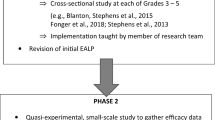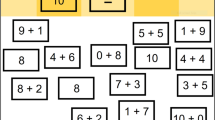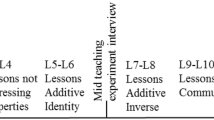Abstract
Decades of research have documented young students’ misinterpretations of the equal sign and the impediments these present for children’s mathematical development. Much less is known about individual differences in adults’ knowledge of the equal sign. We assessed 182 college students from developmental math courses and present analyses from a subset of items on a previously validated assessment of mathematical equality. College students exhibited variability in their interpretations of the equal sign, and these individual differences were related both to their solutions for open equations with variables and to their interpretations of an algebraic expression. Students who provided a relational interpretation of the equal sign were most successful on target algebra problems and students who only provided an operational interpretation of the equal sign were least successful. These results show that misinterpretations of the equal sign can persist well beyond elementary school and can provide a critical indicator of broader mathematical reasoning among college students.







Similar content being viewed by others
References
ACT. (2018). The Condition of College and Career Readiness: National 2018. ACT. Retrieved from https://www.act.org/content/dam/act/unsecured/documents/cccr2018/National-CCCR-2018.pdf.
Alibali, M. W., Knuth, E. J., Hattikudur, S., McNeil, N. M., & Stephens, A. C. (2007). A longitudinal examination of middle school students’ understanding of the equal sign and equivalent equations. Mathematical Thinking and Learning, 9, 221–247. https://doi.org/10.1080/10986060701360902
Behr, M., Erlwanger, S., & Nichols, E. (1980). How children view the equal sign. Mathematics Teaching, 92, 13–15.
Blanton, M., Stephens, A., Knuth, E., Gardiner, A. M., Lsler, I., & Kim, J. S. (2015). The development of children’s early algebraic thinking: The impact of a comprehensive early algebra intervention in third grade. Journal for Research in Mathematics Education, 46, 39–87. https://doi.org/10.5951/jresematheduc.46.1.0039
Byrd, C. E., McNeil, N. M., Chesney, D. L., & Matthews, P. G. (2015). A specific misconception of the equal sign acts as a barrier to children’s learning of early algebra. Learning and Individual Differences, 38, 61–67. https://doi.org/10.1016/j.lindif.2015.01.001
Capraro, R. M., Capraro, M. M., Yetkiner, Z. E., Özel, S., Kim, H. G., & Küçük, A. R. (2010). An international comparison of grade 6 students’ understanding of the equal sign. Psychological Reports, 106, 49–53.
Carpenter, T. P., Franke, M. L., & Levi, L. (2003). Thinking mathematically: Integrating arithmetic and algebra in elementary school. Portsmouth, NH: Heinemann.
Charles, R. I. (2005). Big ideas and understandings as the foundation for elementary and middle school mathematics. National Council for Supervisors of Mathematics: Journal of Mathematics Education Leadership, 8, 9–24.
Chesney, D. L., McNeil, N. M., Brockmole, J. R., & Kelley, K. (2013). An eye for relations: Eye-tracking indicates long-term negative effects of operational thinking on understanding of math equivalence. Memory and Cognition, 41, 1079–1095. https://doi.org/10.3758/s13421-013-0315-8
Chimoni, M., Pitta-Pantazi, D., & Christou, C. (2018). Examining early algebraic thinking: Insights from empirical data. Educational Studies in Mathematics, 98, 57–76.
Collis, K. F. (1974). Cognitive development and mathematics learning. Paper presented at Psychology of Mathematics Education Workshop, Center for Science Education, Chelsea College, London.
Diamond, A., & Kirkham, N. (2005). Not quite as grown up as we like to think: Parallels between cognition in childhood and adulthood. Psychological Science, 16, 291–297. https://doi.org/10.1111/j.0956-7976.2005.01530.x
Falkner, K. P., Levi, L., & Carpenter, T. P. (1999). Children’s understanding of equality: A foundation for algebra. Teaching Children Mathematics, 6, 232–236.
Filloy, E., & Rojano, T. (1989). Solving equations: The transition from arithmetic to algebra. For the Learning of Mathematics, 9, 19–26.
Freiman, V., & Lee, L. (2004). Tracking primary students’ understanding of the equality sign. In M. Hoines & A. Fuglestad (Eds.), Proceedings of the 28th Conference of the International Group for the Psychology of Mathematics Education 2:415–422). Bergen, Norway: PME.
Fyfe, E. R., Matthews, P. G., Amsel, E., McEldoon, K. L., & McNeil, N. M. (2018). Assessing formal knowledge of math equivalence among algebra and pre-algebra students. Journal of Educational Psychology, 110, 87–101. https://doi.org/10.1037/edu0000208
Fyfe, E. R., & Rittle-Johnson, B. (2017). Mathematics practice without feedback: A desirable difficulty in a classroom setting. Instructional Science, 45, 177–194. https://doi.org/10.1007/s11251-016-9401-1
Henrich, J., Heine, S. J., & Norenzayan, A. (2010). Most people are not WEIRD. Nature, 446, 29. https://doi.org/10.1038/466029a
Herscovics, N., & Linchevski, L. (1994). A cognitive gap between arithmetic and algebra. Educational Studies in Mathematics, 27, 59–78.
Jacobs, V. R., Franke, M. L., Carpenter, T. P., Levi, L., & Battey, D. (2007). Professional development focused on children’s algebraic reasoning in elementary school. Journal for Research in Mathematics Education, 38, 258–288.
Jones, I., Inglis, M., Gilmore, C., & Dowens, M. (2012). Substitution and sameness: Two components of a relational conception of the equals sign. Journal of Experimental Child Psychology, 113, 166–176. https://doi.org/10.1016/j.jecp.2012.05.003
Kieran, C. (1981). Concepts associated with the equality symbol. Educational Studies in Mathematics, 12, 317–326. https://doi.org/10.1007/BF00311062
Knuth, E. J., Stephens, A. C., McNeil, N. M., & Alibali, M. W. (2006). Does understanding the equal sign matter? Evidence from solving equations. Journal for Research in Mathematics Education, 37, 297–312.
Küchemann, D. (1978). Children’s understanding of numerical variables. Mathematics in School, 7, 23–26 http://www.jstor.org/stable/30213397
Li, X., Ding, M., Capraro, M. M., & Capraro, R. M. (2008). Sources of differences in children’s understandings of mathematical equality: Comparative analysis of teacher guides and student texts in China and the United States. Cognition and Instruction, 26, 195–217. https://doi.org/10.1080/07370000801980845
Linchevski, L., & Herscovics, N. (1996). Crossing the cognitive gap between arithmetic and algebra: Operating on the unknown in the context of equations. Educational Studies in Mathematics, 30, 39–65.
MacGregor, M., & Stacey, K. (1997). Students’ understanding of algebraic notation. Educational Studies in Mathematics, 33, 1–19. https://doi.org/10.1023/A:1002970913563
Matthews, P., Rittle-Johnson, B., McEldoon, K., & Taylor, R. (2012). Measure for measure: What combining diverse measures reveals about children’s understanding of the equal sign as an indicator of mathematical equality. Journal for Research in Mathematics Education, 43, 316–350. https://doi.org/10.5951/jresematheduc.43.3.0316
McNeil, N. M., & Alibali, M. W. (2005a). Knowledge change as a function of mathematics experience: All contexts are not created equal. Journal of Cognition and Development, 6, 285–306. https://doi.org/10.1207/s15327647/jcd0602_6
McNeil, N. M., & Alibali, M. W. (2005b). Why won’t you change your mind? Knowledge of operational patterns hinders learning and performance on equations. Child Development, 76, 1–17. https://doi.org/10.1111/j.1467-8624.2005.00884.x
McNeil, N. M., Hornburg, C. B., Devlin, B. L., Carrazza, C., & McKeever, M. O. (2017). Consequences of individual differences in children’s formal understanding of mathematical equivalence. Child Development. https://doi.org/10.1111/cdev.12948
McNeil, N. M., Rittle-Johnson, B., Hattikudur, S., & Petersen, L. A. (2010). Continuity in representation between children and adults: Arithmetic knowledge hinders undergraduates’ algebraic problem solving. Journal of Cognition and Development, 11, 437–457. https://doi.org/10.1080/15248372.2010.516421
McNeil, N. M., Weinberg, A., Hattikudur, S., Stephens, A. C., Asquith, P., Knuth, E. J., & Alibali, M. W. (2010). A is for apple: Mnemonic symbols hinder the interpretation of algebraic expressions. Journal of Educational Psychology, 102, 625–634. https://doi.org/10.1037/a0019105
National Center for Education Statistics. (2015). The nation’s report card, National Center for education statistics, Institute of Education Sciences, U. Washington, DC: S. Department of Education. Retrieved from https://www.nationsreportcard.gov
Provasnik, S., Malley, L., Stephens, M., Landeros, K., Perkins, R., & Tang, J. H. (2016). Highlights from TIMSS and TIMSS advanced 2015. U.S. Department of Education. Retrieved from: https://nces.ed.gov/pubs2017/2017002.pdf
Renwick, E. (1932). Children’s misconceptions concerning the symbols for mathematical equality. British Journal of Educational Psychology, 2, 173–183. https://doi.org/10.1111/j.204408279.1932.tb02743.x
Rittle-Johnson, B., Matthews, P. G., Taylor, R. S., & McEldoon, K. (2011). Assessing knowledge of mathematical equivalence: A construct modeling approach. Journal of Educational Psychology, 103, 85–104. https://doi.org/10.1037/a0021334
Sfard, A., & Linchevski, L. (1994). The gains and pitfalls of reification: The case of algebra. Educational Studies in Mathematics, 26, 191–228. https://doi.org/10.1007/978-94-017-2057-1_4
Simsek, E., Xenidou-Dervou, I., Karadeniz, I., & Jones, I. (2019). The conception of substitution of the equals sign plays a unique role in students’ algebra performance. Journal of Numerical Cognition, 5, 24–37.
Skemp, R. R. (1976). Relational understanding and instrumental understanding. Mathematics Teacher, 77, 20–26.
Steinberg, R. M., Sleeman, D. H., & Ktorza, D. (1990). Algebra students’ knowledge of equivalence of equations. Journal for Research in Mathematics Education, 22, 112–121.
Funding
Parts of this research were conducted while Fyfe was financially supported by Institute of Education Sciences, U. S. Department of Education, training grant R305B130007 as part of the Wisconsin Center for Education Research Postdoctoral Training Program.
Author information
Authors and Affiliations
Corresponding author
Ethics declarations
Conflict of interest
The authors declare that they have no conflict of interest.
Additional information
Publisher’s note
Springer Nature remains neutral with regard to jurisdictional claims in published maps and institutional affiliations.
Rights and permissions
About this article
Cite this article
Fyfe, E.R., Matthews, P.G. & Amsel, E. College developmental math students’ knowledge of the equal sign. Educ Stud Math 104, 65–85 (2020). https://doi.org/10.1007/s10649-020-09947-2
Published:
Issue Date:
DOI: https://doi.org/10.1007/s10649-020-09947-2




